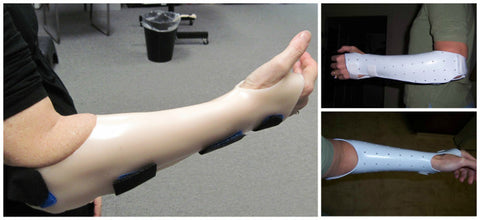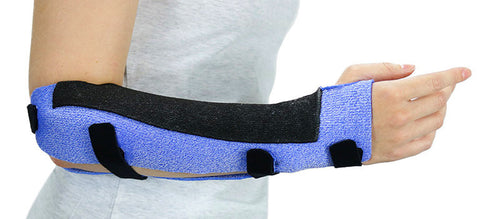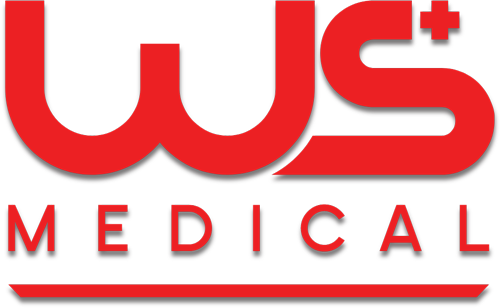The Muenster Orthosis and Sugar Tong Orthosis
The Muenster and Sugar Tong Orthosis are two valuable orthoses that help to prevent full forearm pronation and supination. Both designs help to position the forearm in either a supinated, pronated or neutral position depending on the injured structure that needs to heal.

Muenster Orthosis in Aquafit NS.
Pathology
The Muenster and Sugar Tong Orthosis allow injured tissues and structures to heal without overstretching or shortening of tissue length. This may be particularly important for certain elbow pathologies or after trauma/surgery of the Radius, Ulna, Distal Radial-Ulnar joint (DRUJ), Proximal radial-ulnar joint, and TFCC structures.
Clinical diagnoses that might benefit from the use of a Muenster or Sugar Tong orthoses include the following pathologies:
- TFCC tears
- Galeazzi fracture-dislocations
- DRUJ fractures and dislocations
- Ulnar abutment injuries
Orthotic Design
Muenster and Sugar Tong Orthoses were designed to prevent full forearm rotation, provide stabilization of the radial-ulnar joint and immobilize the DRUJ. At the same time, they allow for limited active flexion and extension of the elbow.
Slaughter et al. (2010) studied the degree to which these orthoses actually limit forearm motion. They found that while the Sugar Tong Orthosis is more effective at preventing forearm pronation than the Muenster Orthosis, neither completely limits full forearm rotation. In the study, participants received proprioceptive feedback that they were reaching limitations in forearm range of motion. Yet, they were still able to rotate through the forearm arc of motion.
These participants, however, had no forearm pathologies. Patients who actually experience painful forearm motion would be instructed to limit full rotation of their forearm. Additionally, pain, swelling and post-operative bandages would further limit motion.
Muenster vs. Sugar Tong Orthosis
Both orthoses will effectively immobilize the forearm, but the fabrication technique is slightly different:
The Muenster Orthosis is essentially a wrist orthosis with long proximal extensions that converge on the medial and lateral epicondyles at the distal humerus.

Examples of a Muenster Orthosis.
The Sugar Tong Orthosis consists of a long and narrow thermoplastic rectangle. Most commonly, it is fabricated with the forearm in neutral. The thermoplastic material is positioned beginning at the dorsal metacarpal heads, along the dorsal aspect of the forearm, around the posterior elbow (capturing the medial and lateral epicondyles), and placed along the volar aspect of the forearm extending to the volar palm.

Sugar Tong Orthosis
Orthotic Fabrication Tips
When fabricating a Muenster or Sugar Tong Orthosis, the patient should be standing or seated. Keep the elbow flexed to 90° and place the forearm in the desired position. You will need full access to the posterior elbow, epicondyles and wrist for the best fabrication technique.
Product Recommendations
Muenster Orthosis
We highly recommend an elastic-based, coated material for the Muenster Orthosis. Orfit NS, Aquafit NS (Orfit Natural NS) and Orfit Colors NS in 3.2 mm (1/8”) all work very well for this design. The non-stick coating of these products makes it possible to pinch the thermoplastic material together at the posterior elbow and on the ulnar border. This keeps both hands free to position the wrist in slight extension and the forearm in a neutral posture.

Muenster Orthosis in Orficast More 30 cm.
Orficast More 30 cm is also a great choice for this orthosis. It allows easy pattern making and application of an otherwise more challenging fabrication. The fabric-like material provides additional comfort and conformity and makes the orthosis extremely light-weight.
Finally, you could also choose a more rigid material: see product recommendations for the Sugar Tong Orthosis.
Sugar Tong Orthosis
This orthosis is best made from a long rectangular strip of a more rigid material: we recommend Orfibrace, Orfit Eco, or Orfit Eco Black NS in 3.2 mm (1/8″).
However, if you are looking for an elastic-based material, you could also use one of the materials we recommend for the Muenster Orthosis.
Written by Debby Schwartz, OTD, OTR/L, CHT
Physical Rehabilitation Product and Educational Specialist at Orfit Industries America.
Debby is a certified hand therapist with over 36 years of clinical experience. She completed her Doctorate of Occupational Therapy at Rocky Mountain University of Health Professions in 2010. She has worked at Orfit Industries America as Product and Educational Specialist since 2007.
Debby is also an adjunct professor at the Occupational Therapy Department of Touro College in NYC and has written many book chapters in the field of hand therapy and multiple articles for hand therapy journals, including the ASHT Times and the Journal of Hand Therapy. She has published a new textbook on orthotic fabrication together with Dr. Katherine Schofield, entitled “Orthotic Design and Fabrication for the Upper Extremity: A Practical Guide”.

